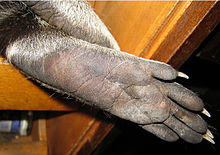Sole walker
Sole walkers are terrestrial vertebrates which, when moving, place the entire autopodium (anatomical hand or anatomical foot), from the wrist to the fingertips or from the heel to the toes, on the ground. This is also known as the plantigrad e gait (from Latin planta '[here] sole of the foot' and Latin gradi ' to walk' ) or plantigradie .
Features and representatives
Sole walkers usually have five functional fingers or toes. In addition, on the one hand, the autopodium is relatively short in relation to the Zeugopodium (anatomical forearm or lower leg) and, on the other hand, the Zeugopodium is usually about as long as the Stylopodium (anatomical upper arm or thigh). In mammals, the skin on the underside (plantar surface) of the entire anatomical foot or the entire anatomical hand is usually hairless and horny (“calloused”).
To the sole-goers are among bears (Ursidae), Small Bears (Procyonidae) and apes (hominids). In the great apes, including humans, the plantigradia is limited to the hind limbs: The representatives outside the genus Homo walk on the back of the hand ( e.g. in the ankle gait ), humans ( Homo ) are obligatorily biped . Many marsupials , including wombats and kangaroos *, are principally plantigrades.
Sole walkers can “switch” to a kind of toe walk (see below ) in order to accelerate optimally or to jump . However, walking on soles generally reaches lower maximum speeds than obligatory point walkers or toe walkers.
Delimitations
A distinction is made between the toe walkers (digitigradie) and the top walkers (unguligradie). However, there are transitional forms with the names semi-plantigrad ("heel" does not touch the ground), semi-digitigrad (heel + proximal metapodium does not touch the ground) and semi-unguligrad (heel + metapodium + most proximal phalanges do not touch the ground) Soil). Thus primates in some textbooks, as plantigrade referred, however, non-hominid primates are classified as semi-plantigrade in specific papers, because in them the tarsus ( "heel") when walking is not the ground ** touches (Engl. Also Heel- called up plantigrady ).
Developmental aspects
The sole gait in the broader sense (including semi-plantigradie) is the original gait of terrestrial vertebrates. It occurs in many land vertebrates with a conservative habitus, for example in tailed amphibians and " lizards " (Lacertilia). The early archosaurs , from which the plantigrade crocodiles are still derived today , had a plantigrade to semi-plantigrade gait. Trace fossils such as chirotherium prove this. In the two main lines of development of the amniotes , Sauropsida and Synapsida , digitigradie and unguligradie or semi-unguligradie developed several times independently of one another ( convergent ).
Remarks
- * Kangaroos represent a special case here: They actually move quadruped-plantigrad over very short distances at very low speeds. The normal mode of locomotion is bipedal hopping (saltatory locomotion), in which only the toes touch the ground (digitigradie), making the kangaroo's foot skeleton more similar to that of a toe walker than that of a typical sole walker.
- ** However, many non-hominid primates prefer to climb trees. They move on almost horizontal branches by placing their weight on the wrists and ankles and the proximal end of the metapodium, while the palms and feet lie across the trunk on the branch or grip it. This type of locomotion, which is also practiced by great apes in appropriate situations, is called palmigradie .
literature
- Christopher McGowan: The Raptor and the Lamb - Predators and Prey in the Living World , Penguin Books, London 1998, ISBN 0-14-027264-X
- P. David Polly: Limbs in mammalian evolution. Pp. 245-268 in: Brian K. Hall (Ed.): Fins into Limbs: Evolution, Development, and Transformation. University of Chicago Press, Chicago 2007, ISBN 978-0-226-31336-8
- Wilfried Westheide, Reinhard Rieger (Hrsg.): Special zoology. Part 2: vertebrates or skulls. 2nd Edition. Spectrum Academic Publishing House, Berlin / Heidelberg 2010, ISBN 978-3-8274-2039-8
Web links
Individual evidence
- ^ Karl Ernst Georges: Comprehensive Latin-German concise dictionary . 8th, improved and increased edition. Hahnsche Buchhandlung, Hanover 1918 (HTML version of the digitized version at zeno.org: planta , gradior - for "gradior", as is customary in Latin, not the infinitive , but the first person singular indicative present passive, not active, because deposit ) .
- ↑ Vera Weisbecker, Michael Archer: Parallel Evolution of Hand Anatomy in Kangaroos and Vombatiform Marsupials: Functional and Evolutionary Implications. Paleontology. Vol. 51, No. 2, 2008, pp. 321–338, doi : 10.1111 / j.1475-4983.2007.00750.x ( Open Access )
- ^ BS Tomar, SB Singh: Evolutionary Biology. 8th revised edition. Rastogi Publications, Meerut 2003, ISBN 81-7133-639-6 , p. 145
- ↑ CB Cunningham, N. Schilling, C. Anders, DR Carrier: The influence of foot posture on the cost of transport in humans. The Journal of Experimental Biology. Vol. 213, 2010, pp. 790–797, doi : 10.1242 / jeb.038984 ( Open Access )
- ^ Daniel L. Gebo: Locomotor Function across Primates (Including Humans). Pp. 530-544 in Clark Spencer Larsen (Ed.): A Companion to Biological Anthropology. Wiley-Blackwell, 2010, ISBN 978-1-405-18900-2 , p. 532
- ↑ Kevin D. Hunt, John GH Cant, Daniel L. Gebo, Michael D. Rose, Suzanne E. Walker, Dionisios Youlatos: Standardized Descriptions of Primate Locomotor and Postural Modes. Primates. Vol. 37, No. 4, 1996, pp. 363–387, doi : 10.1007 / BF02381373 (alternative full text access : Indiana University PDF 3.9 MB)

